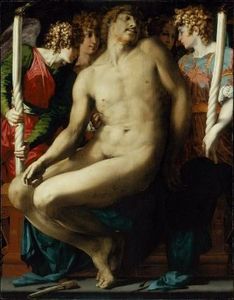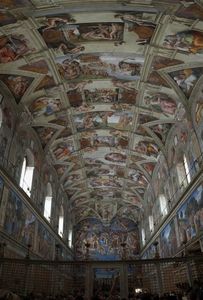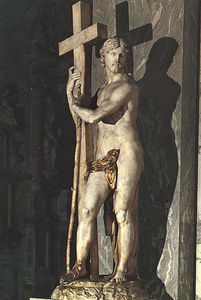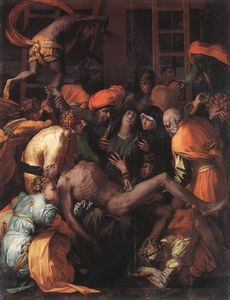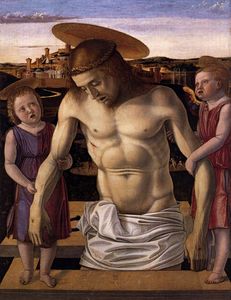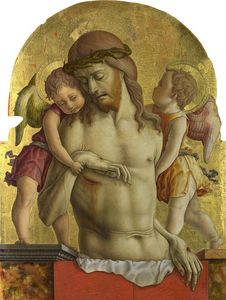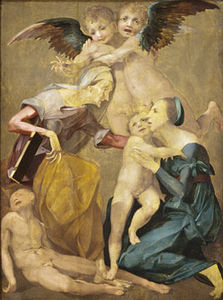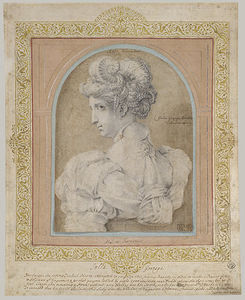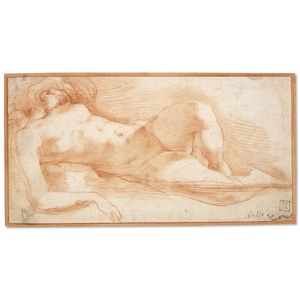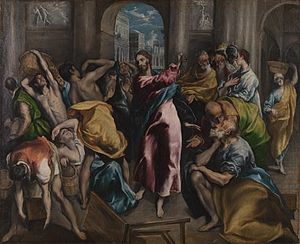Dead Christ with Angels
- Date of Creation:
- circa 1527
- Height (cm):
- 133.40
- Length (cm):
- 104.10
- Medium:
- Oil
- Support:
- Wood
- Subject:
- Figure
- Art Movement:
- Mannerism
- Created by:
- Current Location:
- Boston, Massachusetts
- Displayed at:
- Museum of Fine Arts Boston
- Owner:
- Museum of Fine Arts Boston
- Dead Christ with Angels Page's Content
- Story / Theme
- Inspirations for the Work
- Analysis
- Related Paintings
- Artist
- Art Period
- Bibliography
Dead Christ with Angels Story / Theme
After arriving in Rome, Rosso Fiorentino's style took a departure from the raw and, at times, violent emotional stance of his earlier works. Under the influence of Michelangelo's and Raphael's mature paintings the artist obtained a newfound fascination with the beauty of the idealized human figure and his subdued emotional appeal is evident in Dead Christ with Angels. This is achieved through a medley of simplistic composition, warm lighting, and softened color tones.
Painted in 1527 for his friend and patron, the Florentine Bishop Leonardo Tornabuoni, this work depicts the quiet moment after the crucifixion in which Christ has been removed from the cross and has been left by his followers for a moment of repose.
Christ lies languidly, supported by four curly-haired angels. His body is the focal point of the painting, taking up the majority of the scene.
Rather than a scene of gore or death, this Christ looks more as if he has been sleeping gently, and the only indications that he has been crucified are the nails on the ground below him, the delicate, thin crown of thorns he sports, and the small wound on his side that one of the angels caresses.
Dead Christ with Angels Inspirations for the Work
When Rosso made his voyage to Rome, he was exposed to works by other Renaissance masters such as Michelangelo, along with works of classical antiquity that had been recently discovered and put on display. This appears to have inspired him in the formation of Dead Christ with Angels.
Michelangelo:
The influence of Michelangelo's nudes, (particularly those of the Sistine Chapel ceiling as well as his Risen Christ), is highly apparent in the anatomically perfect body of Christ: a departure from the angular figures and sallow tones of Fiorentino's earlier nudes.
The body is classical, elegant, and refined, arranged in a sensuous, reclining position. The skin is supple, soft, and retains a lifelike look despite its apparent state of mortem.
The emphasis here is not so much on shock value as with his earlier works, but on the harmonious qualities of the human figure as represented in Christ.
Depicting him as completely nude is also a departure from most other representations and hints at the eroticism that was to become more apparent in Fiorentino's work at Fontainebleau.
Classical Antiquity:
It has been noted that the nude figure depicted in Dead Christ with Angels owes more to the classical ideals of ancient Greek and Roman sculpture of pagan Gods than to previously seen representations of Jesus Christ.
Dead Christ with Angels Analysis
The most remarkable trait of Dead Christ with Angels that has been duly noted by critics over the years is the subdued emotional quality in comparison to the artist's earlier works.
Fiorentino's maturation is made apparent through the total shift in tone and technique from scattered and abrasive compositional elements to a greater focus on physical beauty and harmony within the painting.
Composition:
The body of Christ takes up the majority of the compositional space and is the focal point of this piece.
Color palette:
Another departure from Fiorentino's earlier style is the use of color, which while remaining offbeat is far from the dissonance of his previous works.
The tones are rich and vibrant and lend an overall sense of warmth to the composition. Primary colors are utilized in the garments and background, and in Christ's body there are golden tones.
Use of light:
The lighting effect is diffused, illuminating the exposed body of Christ in a divine, golden bath, with the angels' curls reflecting this tone. There is stark contrast between the areas of light and dark, creating a dramatic emphasis on the figure of Christ.
Tone:
Hushed, serene, warm, and just this side of sentimental, Fiorentino's Dead Christ with Angels presents a scene of repose
Dead Christ with Angels Related Paintings
Dead Christ with Angels Artist
Dead Christ with Angels was one of Fiorentino's intermediate works, completed in Rome after working in the workshop of Andrea del Sarto. At this time he was honing his unique style that would set him apart from other painters of the day, before his displacement due to the Sack of Rome.
The painting disappeared for hundreds of years only to resurface at the Museum of Fine Arts in Boston, where it still resides. This was a fortunate emergence, as the work is considered to be one of Fiorentino's finest paintings, and only one of the few from this intermediate time period that survives.
It illustrates his progression as a painter and bridges the gap between his early, violently emotive works and the refined, decorative eroticism of Fontainebleau.
Rosso Fiorentino was an artist of diverse talents with a completely unique way of seeing the world. Fiery, restless and imaginative, Fiorentino made no shortage of enemies, yet inspired awe and respect wherever his travels took him as his talent and foresight was undeniable, not to mention his charm, grace and good looks.
As his contemporary Giorgio Vasari put it, "he was a man of splendid presence, with a gracious and serious manner of speaking, a good musician, and with a knowledge of philosophy. "
Fiorentino almost single handedly pioneered a new movement in art known as Mannerism, and though he was derided by art critics for centuries afterwards, he has in modern years finally garnered the accolades he deserves along with the recognition as a rebel before his time.
Fiorentino was unafraid to take conventions established by the Renaissance and turn them upside down, linking him with maverick talents of the modern era, from Surrealists to Abstract Expressionists.
Dead Christ with Angels Art Period
After the idealism and perfectionism of the Renaissance, artists were eager to branch out and stretch the forms of artistic license. Dead Christ with Angels is a prime example of this new form of artistic expansion, which was to be called Mannerism.
Mannerism was a period of European art history that followed closely on the heels of the Renaissance movement. While some critics consider Mannerism as part of the Late Renaissance, others classify this as a distinct period occurring between 1520 and 1600 that represented a break from many of the artistic values of the Renaissance, as naturalism gave way to the surreal.
The perception of not only Rosso Fiorentino but other Mannerists that followed, has fluctuated over the centuries, and only relatively recently have they been seen in a positive light.
Fiorentino in particular was criticized for the contorted poses of his figures, as well as the fact that they often appeared somewhat thin, haggard, or skeletal.
Fortunately, in the 1950s art critics and historians started to see the Mannerists, including Fiorentino, in a different light. In fact, they did an about face in their stance on the movement, praising Mannerism for the traits they had previously counted as disabilities.
Fiorentino, with his distorted use of space and elongated figures, desire to shock and rebel against the accepted standards of the day, seems to have more in common with Modern artists than the Renaissance artists of the time.
Dead Christ with Angels Bibliography
To find out more about Rosso Fiorentino and the Mannerist era please choose from the following recommended sources.
• Carlo, Falciani. Il Rosso Fiorentino. Olschki, 1996
• Carroll, Eugene A. & Fiorentino, Rosso. Rosso Fiorentino: Drawings, Prints, and Decorative Arts. National Gallery of Art, 1987
• Franklin, David. Rosso in Italy: Italian Career of Rosso Fiorentino. Yale University Press, 1994
• Letta, Elisabetta M. Pontormo and Rosso Fiorentino. Scala Riverside, 2001
• Natali, Antonio. Rosso Fiorentino. Silvana, 2007
• Vasari, Giorgio. Lives of the Artists: A Selection. Penguin Classics, 1987

